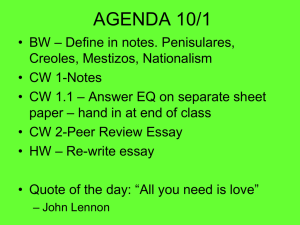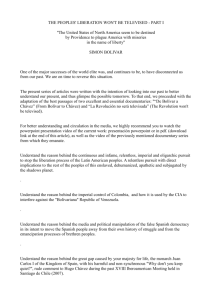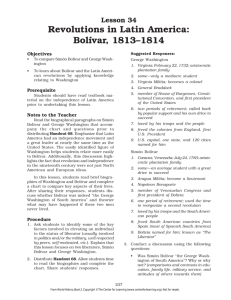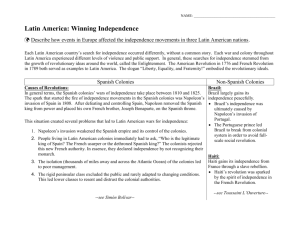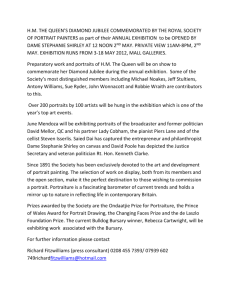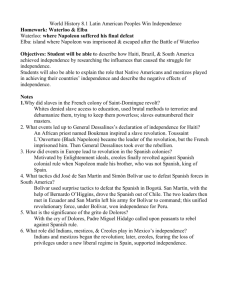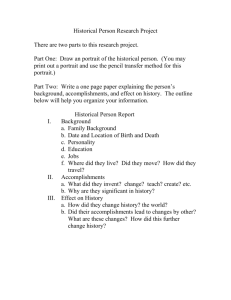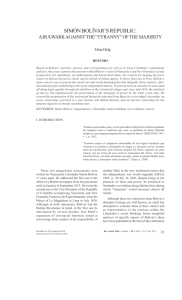Community Symbols: Heroes and Leaders
advertisement
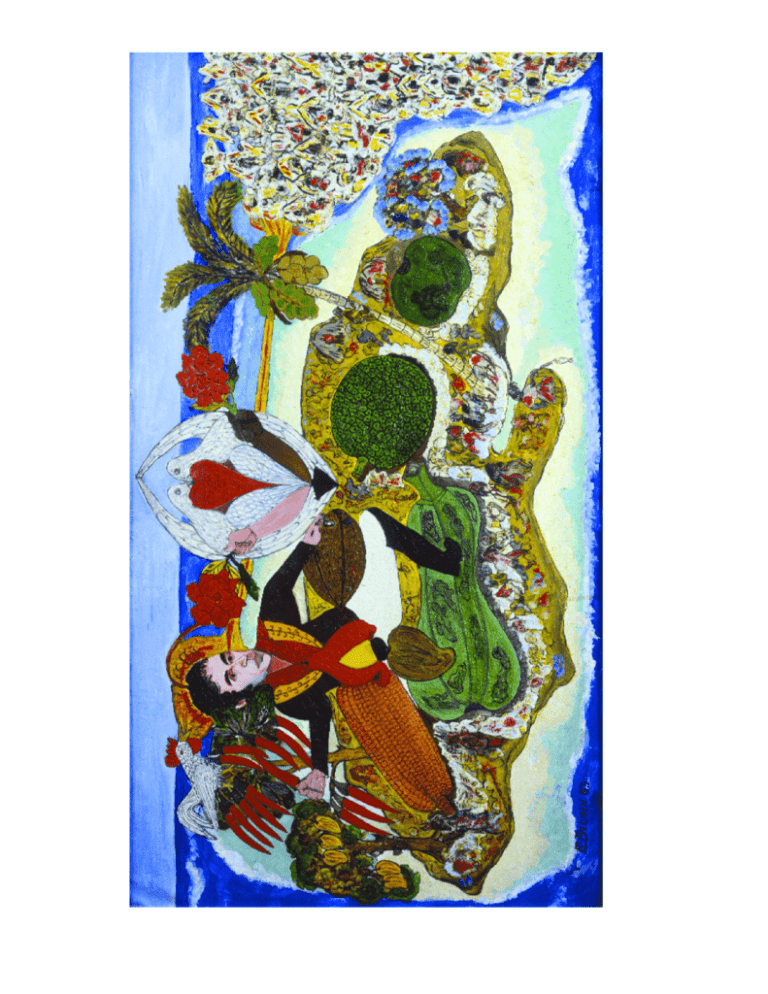
TH E AS CE NS IO N OF S IM ÓN B O L Í VAR O N M OU NT JA M A I CA Everald Brown (1917–2002) Jamaica; 1983 Oil on canvas; 20 1 ⁄2 × 37 1 ⁄2'' Gift of Maurice C. and Patricia L. Thompson, 2003.20.8 Photo by Gavin Ashworth, New York BAC KGR O U ND I NFO R M AT IO N ON T HE OB J ECT Venezuelan Simón Bolívar (1783–1830), who has been called the “George Washington of South America,” fought for Latin America’s independence from Spain during the time of Spanish colonial rule. He believed that unity was crucial for Latin Americans to support one another and work together as a people to free their lands. Also known as “El Libertador,” Bolívar led the fight for liberation of what are now Venezuela, Colombia, Panama, Ecuador, Peru, and Bolivia, becoming a hero to many in Central and South America. The newly independent country of Bolivia, of which Bolívar was the first president, was named in his honor. Everald Brown, a Jamaican artist, painted this portrait of Símon Bolívar, depicting him larger than life, standing on the island of Jamaica. Bolívar is dressed in military regalia and smiling broadly. He is straddling Mount Jamaica, surrounded by the rich natural resources of the island. In each hand he is holding typical Jamaican produce—a red chili and a coconut. A rooster crows into the general’s ear; the message delivered travels through Bolívar’s head and emerges, streamlike, on the coast of Africa. That continent, which for centuries also was dominated by colonialism and oppression, is depicted as a mass of huts teeming with people. This may be symbolic of Bolívar’s dream that the spirit of independence, unity, and freedom from colonial rule would travel to and inspire the African colonies. The Ascension of Simón Bolívar on Mount Jamaica is rife with symbols of the beliefs and ideals Bolívar represents to the artist, including two birds that form a heart and white and black arms each holding a rose bouquet as offerings of hope for freedom, equality, and liberation. 2 R E L ATED L ESS O N S • • “Community Symbols: Heroes and Leaders” (4–5) “Exploring Folk Art Through Poetry” (2–3) C o m m u n i t y Symbols: Heroes and Leaders G RAD E L EV EL : 4– 5 N EW YOR K STATE L E AR N IN G STA N DA R DS : T HE A RTS, EN GL I SH L A N G UAG E ARTS, A ND S OCI AL ST U D I E S EST I M AT ED T I M E: T WO 45 -M IN U TE P ER I OD S O B J ECT I V ES • • • Students will learn that portraits often depict people of great importance to their communities. Students will analyze a portrait through extended observation and inquiry. After learning the biography of the portrait’s subject, students will revisit their interpretations of the painting. Students will create portraits of individuals they have identified as being of symbolic importance to their community. M AT E R I A L S • • • • Images of The Ascension of Simón Bolívar on Mount Jamaica Copies of the Portrait Worksheet (one for each student) Writing and sketching materials Art supplies for painting, drawing, printmaking, or sculpture L ESS ON ACT I V I T I ES AN D P R OCESS ES Day One Introduction • • • • Introduce or review the concept of a portrait. A portrait is a painting, drawing, sculpture, or other work of visual art that captures the likeness of a person, most often focusing on the face. What does a portrait tell us about the person it depicts? Oftentimes, a portrait captures more than what a person physically looks like; it also gives the viewer insight into the subject’s character or beliefs. Ask the students to consider how a portrait might show them such features. Ask the students to think about their own portraits. How would they pose for pictures? Ask for a few volunteers to pose for the class pretending to photograph them. What do their facial expressions, body language, and poses say about their characters or beliefs? How would they pose if they wanted to look tough, powerful, sweet, etc.? Tell the students that portraits are made of ordinary people and also of people who may have special importance to their communities. 3 Discussion View and discuss a reproduction of The Ascension of Simón Bolívar on Mount Jamaica, analyzing the portrait before introducing the background information on the artwork. Given that this is a complex and richly detailed painting, allow time for close observation. • Begin the discussion by asking the students to describe the elements they find most interesting. Encourage them to share their observations and give their attention to aspects of the painting their classmates point out. Considering there is so much imagery and information to take in, let the students continue observing and describing the work until a full description has been formed before moving on to analyzing the meaning of the painting. • Discuss the physical appearance and characteristics of the subject. Ask the students to consider the subject’s pose, facial expression, and clothing. • Consider the backdrop and all the elements that surround the subject. • Can you position your body the way the portrayed person poses in the painting? How do you feel in this position? • What ideas do you have about this person? • What might he symbolize or stand for? • What ideas do the things that surround him—the rooster, the birds, the heart, the roses, the hands, etc.—symbolize? • What would you call this painting if you had to give it a title? • Introduce the background information about The Ascension of Simón Bolívar on Mount Jamaica, relating the ideas the students touched upon in their observation and discussion, as well as the questions that interested them, to this new information. • Read A Picture Book of Simón Bolívar by David A. Adler or visit the websites recommended at the end of this lesson plan to learn more about Bolívar. Day Two Activity • • • • 4 Brainstorm individuals who are community symbols. What do these people symbolize? The students may think about symbolic figures from different periods in history whom they have encountered in their studies. Each student may choose his or her own hero or leader; there may be overlap in some of the students’ choices. Once the students have each chosen an individual, have them complete their Portrait Worksheets in preparation for the portraits they will create. (If necessary or desirable, research may be conducted in school or as a homework assignment.) The students should explain the significance of their subjects in writing and prepare a sketch before beginning the final artwork. Observe and assist the students as they create their portraits. The works can be executed in the medium deemed most appropriate for the class. • Remind the students to pay particular attention to the details that are included in their works. How can we identify the subject of their portraits? How can we find insight into the characters or beliefs of the portrayed subjects? P R E- AN D P OST- L ESS ON ACT IV I T Y S U GG EST I O N S • • • • Create a “Gallery of Community Heroes and Leaders.” Have each student choose an individual he or she believes is a community symbol. The students should research their subjects, locating portraits as well as biographical and historical information. Each student should write a short label explaining the individual’s role as a symbol for the community to hang next to the image they found. The students should be encouraged to read one another’s labels and discuss their individual choices. Visit the American Folk Art Museum for a guided tour. Conduct this lesson before or after your museum visit. The “Family Portraits” lesson designed for pre-K–grade 1, in which students create individual portraits of each of their family members unified by one reoccurring visual element, may be adapted for use with older students and taught in conjunction with this lesson. The “Artist as Activist” lesson, which concerns addressing social issues through art, may be taught in conjunction with this lesson. AS S ESS M E N T/ EVA LUAT ION M E TH ODS • • • Students participated in discussion, observing and analyzing the presented portrait. Students were able to identify individuals of symbolic importance to their community and support their identifications with evidence. Students created portraits of symbolic figures in their communities, thoughtfully including symbols that represent the person’s character or beliefs. R ECOM M E ND ED R ESO U R C ES Recommended Book for Students Adler, David A. A Picture Book of Simón Bolívar. New York: Holiday House, 1992. A picture-book biography of Simón Bolívar for elementary-school students. Recommended Websites Biblioteca Virtual de Simón Bolívar [Virtual Library of Simón Bolívar]: www.geocities.com/Athens/Acropolis/7609/eng/toc/html An informational website in English and Spanish for adults featuring selected writings on and by Bolívar. 5 Embassy of the Bolivarian Republic of Venezuela in the United States of America: “Venezuela for Kids—Simón Bolívar” www.embavenez-us.org/kids.venezuela/simon.bolivar.htm A comprehensive history and biogra p hy of the Venezuelan national hero in Spanish and English. The Official Website for Central Park: Simón Bolívar sculpture info page www.centralparknyc.org/virtualpark/southend/simonbolivar Features a photograph of a statue of Simón Bolívar on horseback in New York’s Central Park; a map marks the statue’s location in the park. Universidad de los Andes, Mérida, Venezuela: “Bolívar para los niños” www.bolivar.ula.ve/indininos.htm A multimedia Spanish-language website presenting history, bibliography, primary-source documents, artwork, and more to supplement the study of Simón Bolívar. 6 Po rt r a i t Wo r k s h e e t Name: Subject of portrait: Describe the subject of your portrait. How does this person look? How will your subject be posing? What clothing will your subject be wearing? What does this person symbolize or stand for? What symbols will you use to show your subject’s character, ideas, beliefs, or principles? Make a rough sketch of the subject of your portrait.
